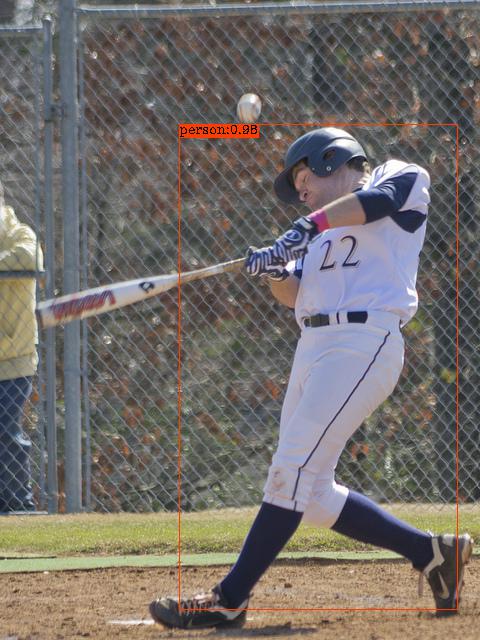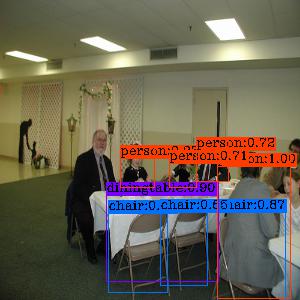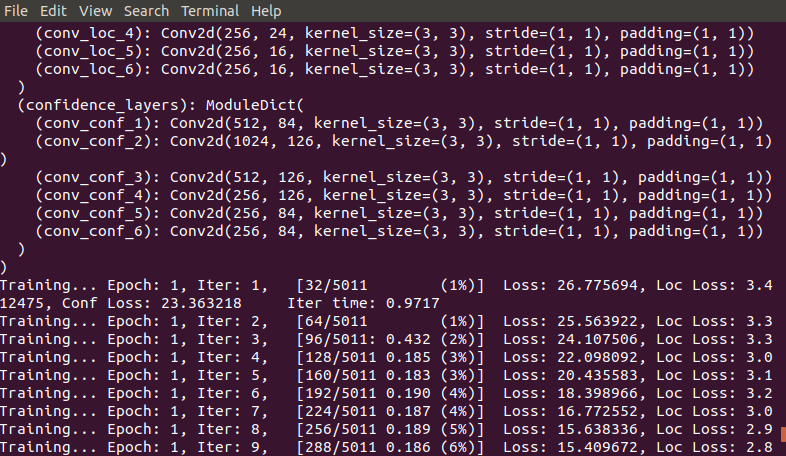The implementation of SSD (Single shot detector) in PyTorch.
- Implement SSD300
- Implement SSD300 with batch normalization
- Implement SSD512
- Implement SSD512 with batch normalization
- Visualize inference result
- Arg parse (easy training)
- Share pre-trained weights →SSD300's model has shared partially!
- Well-introduction?
- Support COCO Dataset
- Support Custom Dataset
- Speed up
- mAP (I have no confidence...)
-
Anaconda
conda install -c anaconda pycurl conda install -c pytorch pytorch conda install -c conda-forge numpy opencv ffmpeg scipy jupyter_contrib_nbextensions jupyter_nbextensions_configurator pycocotools
-
pip (optional)
pip install git+https://github.com/jjjkkkjjj/pytorch_SSD.git
-
Jupyter
jupyter notebook
-
You can download VOC2007-trainval, VOC2007-test, VOC2012-trainval, VOC2012-test, COCO2014-trainval and COCO2014-test dataset following command;
python get_dataset.py --datasets [{dataset name} {dataset name}...]{dataset name}is;voc2007_trainvalvoc2007_testvoc2012_trainvalvoc2012_testcoco2014_trainvalcoco2017_trainval
You can train (your) voc or coco style dataset easily when you use easy_train.py!
Example;
python easy_train.py VOC -r {your-voc-style-dataset-path} --focus trainval -l ball person -lr 0.003or
python easy_train.py COCO -r {your-coco-style-dataset-path} --focus train2012 -l ball person -lr 0.003usage: easy_train.py [-h] [-r DATASET_ROOTDIR [DATASET_ROOTDIR ...]]
[--focus FOCUS [FOCUS ...]] [-l LABELS [LABELS ...]]
[-ig [{difficult,truncated,occluded,iscrowd} [{difficult,truncated,occluded,iscrowd} ...]]]
[-m {SSD300,SSD512}] [-n MODEL_NAME] [-bn]
[-w WEIGHTS_PATH] [-bs BATCH_SIZE] [-nw NUM_WORKERS]
[-d {cpu,cuda}] [-si START_ITERATION] [-na]
[-optimizer {SGD,Adam}] [-lr LEARNING_RATE]
[--momentum MOMENTUM] [-wd WEIGHT_DECAY]
[--steplr_gamma STEPLR_GAMMA]
[--steplr_milestones STEPLR_MILESTONES [STEPLR_MILESTONES ...]]
[-mi MAX_ITERATION] [-ci CHECKPOINTS_INTERVAL]
[--loss_alpha LOSS_ALPHA]
{VOC,COCO}
Easy training script for VOC or COCO style dataset
positional arguments:
{VOC,COCO} Dataset type
optional arguments:
-h, --help show this help message and exit
-r DATASET_ROOTDIR [DATASET_ROOTDIR ...], --dataset_rootdir DATASET_ROOTDIR [DATASET_ROOTDIR ...]
Dataset root directory path. If dataset type is 'VOC',
Default is; '['/home/kado/data/voc/voc2007/trainval/VO
Cdevkit/VOC2007']' If dataset type is 'COCO', Default
is; '['/home/kado/data/coco/coco2014/trainval']'
--focus FOCUS [FOCUS ...]
Image set name. If dataset type is 'VOC', Default is;
'['trainval']' if dataset type is 'COCO', Default is;
'['train2014']'
-l LABELS [LABELS ...], --labels LABELS [LABELS ...]
Dataset class labels. If dataset type is 'VOC',
Default is; '['aeroplane', 'bicycle', 'bird', 'boat',
'bottle', 'bus', 'car', 'cat', 'chair', 'cow',
'diningtable', 'dog', 'horse', 'motorbike', 'person',
'pottedplant', 'sheep', 'sofa', 'train', 'tvmonitor']'
If dataset type is 'COCO', Default is; '['person',
'bicycle', 'car', 'motorcycle', 'airplane', 'bus',
'train', 'truck', 'boat', 'traffic light', 'fire
hydrant', 'stop sign', 'parking meter', 'bench',
'bird', 'cat', 'dog', 'horse', 'sheep', 'cow',
'elephant', 'bear', 'zebra', 'giraffe', 'backpack',
'umbrella', 'handbag', 'tie', 'suitcase', 'frisbee',
'skis', 'snowboard', 'sports ball', 'kite', 'baseball
bat', 'baseball glove', 'skateboard', 'surfboard',
'tennis racket', 'bottle', 'wine glass', 'cup',
'fork', 'knife', 'spoon', 'bowl', 'banana', 'apple',
'sandwich', 'orange', 'broccoli', 'carrot', 'hot dog',
'pizza', 'donut', 'cake', 'chair', 'couch', 'potted
plant', 'bed', 'dining table', 'toilet', 'tv',
'laptop', 'mouse', 'remote', 'keyboard', 'cell phone',
'microwave', 'oven', 'toaster', 'sink',
'refrigerator', 'book', 'clock', 'vase', 'scissors',
'teddy bear', 'hair drier', 'toothbrush']'
-ig [{difficult,truncated,occluded,iscrowd} [{difficult,truncated,occluded,iscrowd} ...]], --ignore [{difficult,truncated,occluded,iscrowd} [{difficult,truncated,occluded,iscrowd} ...]]
Whether to ignore object
-m {SSD300,SSD512}, --model {SSD300,SSD512}
Trained model
-n MODEL_NAME, --model_name MODEL_NAME
Model name, which will be used as save name
-bn, --batch_norm Whether to construct model with batch normalization
-w WEIGHTS_PATH, --weights_path WEIGHTS_PATH
Pre-trained weights path. Default is pytorch's pre-
trained one for vgg
-bs BATCH_SIZE, --batch_size BATCH_SIZE
Batch size
-nw NUM_WORKERS, --num_workers NUM_WORKERS
Number of workers used in DataLoader
-d {cpu,cuda}, --device {cpu,cuda}
Device for Tensor
-si START_ITERATION, --start_iteration START_ITERATION
Resume training at this iteration
-na, --no_augmentation
Whether to do augmentation to your dataset
-optimizer {SGD,Adam}
Optimizer for training
-lr LEARNING_RATE, --learning_rate LEARNING_RATE
Initial learning rate
--momentum MOMENTUM Momentum value for Optimizer
-wd WEIGHT_DECAY, --weight_decay WEIGHT_DECAY
Weight decay for SGD
--steplr_gamma STEPLR_GAMMA
Gamma for stepLR
--steplr_milestones STEPLR_MILESTONES [STEPLR_MILESTONES ...]
Milestones for stepLR
-mi MAX_ITERATION, --max_iteration MAX_ITERATION
-ci CHECKPOINTS_INTERVAL, --checkpoints_interval CHECKPOINTS_INTERVAL
Checkpoints interval
--loss_alpha LOSS_ALPHA
Loss's alpha-
Caution!!
When your terminal window is small, print training summary for each iteration
To avoid this, please expand your terminal window.
See also training-voc2007+2012.ipynb or training-voc2007.ipynb.
-
First, create
augmentation,transform,target_transforminstance usingaugmentations,transformsandtarget_transformsmodule indataExample;
from ssd_data import transforms, target_transforms, augmentations ignore = target_transforms.Ignore(difficult=True) augmentation = augmentations.AugmentationOriginal() transform = transforms.Compose( [transforms.Resize((300, 300)), transforms.ToTensor(), transforms.Normalize(rgb_means=(0.485, 0.456, 0.406), rgb_stds=(0.229, 0.224, 0.225))] ) target_transform = target_transforms.Compose( [target_transforms.ToCentroids(), target_transforms.OneHot(class_nums=datasets.VOC_class_nums, add_background=True), target_transforms.ToTensor()] )
Note that None is available to set these instances
-
Second, load dataset from
datasetsmodule indata.Example;
from ssd_data import datasets from ssd_data import _utils train_dataset = datasets.VOC2007Dataset(ignore=ignore, transform=transform, target_transform=target_transform, augmentation=augmentation) train_loader = DataLoader(train_dataset, batch_size=32, shuffle=True, num_workers=4, collate_fn=_utils.batch_ind_fn)
You can use
datasets.Composeto combine plural datasets. -
Third, create model. You can create model with specified device by
.to(device)Example;
from ssd.models.ssd300 import SSD300 model = SSD300(class_labels=train_dataset.class_labels, batch_norm=False).cuda() model.load_vgg_weights()
You can load your trained weights by using
model.load_weights(path)too. -
Last, create
Optimizer,SaveManager,LogManagerandTrainLoggerto train.Example;
from torch.utils.data import DataLoader from torch.optim.sgd import SGD from torch.optim.adam import Adam from ssd.train import * optimizer = SGD(model.parameters(), lr=1e-3, momentum=0.9, weight_decay=5e-4) # slower #optimizer = Adam(model.parameters(), lr=1e-3, weight_decay=5e-4) # faster iter_sheduler = SSDIterMultiStepLR(optimizer, milestones=(40000, 50000), gamma=0.1, verbose=True) save_manager = SaveManager(modelname='ssd300-voc2007', interval=5000, max_checkpoints=15, plot_yrange=(0, 8)) log_manager = LogManager(interval=10, save_manager=save_manager, loss_interval=10, live_graph=LiveGraph((0, 8))) trainer = TrainLogger(model, loss_func=SSDLoss(), optimizer=optimizer, scheduler=iter_sheduler, log_manager=log_manager) trainer.train(60000, train_loader)
-
Result Learning curve example(voc2007-trainval and voc2007-test)
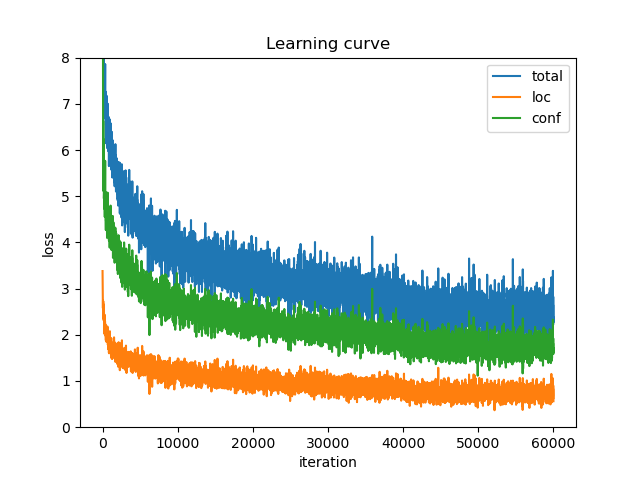
Learning curve example(voc2007-trainval and voc2012-trainval)
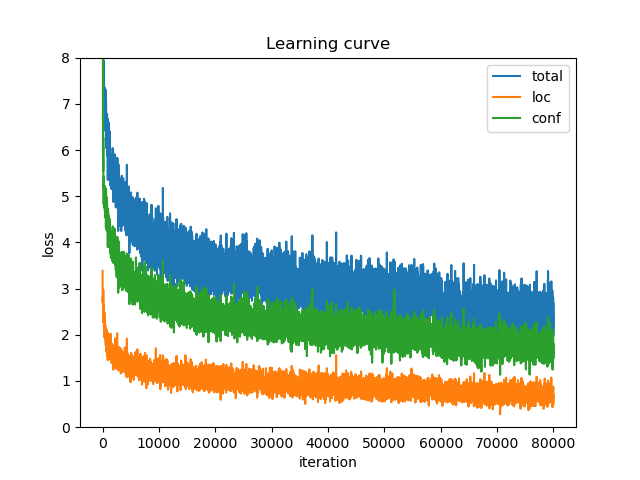
-
First, create model. You can create model with specified device by
.to(device)Example;
from ssd.models.ssd300 import SSD300 from ssd_data import datasets model = SSD300(class_labels=datasets.VOC_class_labels, batch_norm=False).cuda() model.load_weights('./weights/ssd300-voc2007/ssd300-voc2007_i-60000.pth') model.eval() ## Required!!!
-
Pass image and show.
Example;
# must be passed RGB order image = cv2.cvtColor(cv2.imread('assets/coco_testimg.jpg'), cv2.COLOR_BGR2RGB) # imgs is list of ndarray(img) infers, imgs = model.infer(cv2.resize(image, (300, 300)), visualize=True, toNorm=True) for img in imgs: # returned img order is BGR cv2.imshow('result', cv2.cvtColor(img, cv2.COLOR_RGB2BGR)) cv2.waitKey()
Result;
※mAP for voc2007test
| SSD300 (no batchnormed) | SSD512 (no batchnormed) | |
|---|---|---|
| VOC2007 | mAP: 0.7572 | mAP: |
| VOC2007++ | mAP: N/A | mAP: |
| VOC2007+2012 | mAP: 0.7636 | mAP: |
| VOC2007+2012+COCO | mAP: 0.7682 | mAP: |
-
Default Box in SSD300 has been implemented in dbox.py
-
Encode in codec.py
-
Decode in codec.py
